Septal leads - Study guides, Class notes & Summaries
Looking for the best study guides, study notes and summaries about Septal leads? On this page you'll find 1208 study documents about Septal leads.
Page 3 out of 1.208 results
Sort by
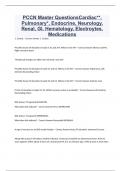
-
PCCN Master QuestionsCardiac**, Pulmonary*, Endocrine, Neurology, Renal, GI, Hematology, Electroytes, Medications
- Exam (elaborations) • 33 pages • 2023
-
- $9.99
- + learn more
PCCN Master QuestionsCardiac**, Pulmonary*, Endocrine, Neurology, Renal, GI, Hematology, Electroytes, Medications 1. Cardiac - Correct Answer 1. Cardiac Pt's EKG shows ST elevation in leads II, III, and aVF. Where is the MI? - Correct Answer Inferior wall MI, Right coronary artery "Reciprocal changes are often seen ini leads I and aVL" Pt's EKG shows ST elevation in leads V1 and V2. Where is the MI? - Correct Answer Septal area, Left Anterior Descending Artery Pt's EKG shows ST...
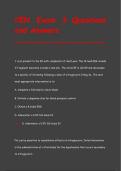
-
CEN Exam 3 Questions and Answers
- Exam (elaborations) • 117 pages • 2024
- Available in package deal
-
- $14.49
- + learn more
1. A pt present to the ED with complaints of chest pain. The 12-lead EKG reveals ST segment elevation in leads I and aVL. The initial BP is 112/69 and decreases to a systolic of 60 mmHg following a dose of nitroglycerin 0.4mg SL. The next most appropriate intervention is to: A. Complete a fibrinolytic check sheet B. Initiate a dopamine drip for blood pressure control C. Obtain a R sided EKG D. Administer a 0.9% NS bolus IV Ans- D. Administer a 0.9% NS bolus IV Pts can be sensiti...
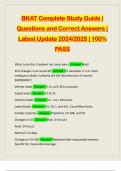
-
BKAT Complete Study Guide | Questions and Correct Answers | Latest Update 2024/2025 | 100% PASS
- Exam (elaborations) • 19 pages • 2024
-
- $11.99
- + learn more
BKAT Complete Study Guide | Questions and Correct Answers | Latest Update 2024/2025 | 100% PASS What to do first if patient has chest pain. - Answer -Rest! ECG changes in an acute MI - Answer -ST elevation in 2 or more contiguous leads. Ischemia d/t full thickness loss of muscle. EMERGENCY. Inferior leads - Answer -II, III, aVF. RCA occlusion. Septal leads - Answer -V1 & V2. Anterior leads - Answer -V1 - V4. LAD lesion. Lateral leads - Answer -V5, V6, I, and aVL. Circumflex lesion. C...
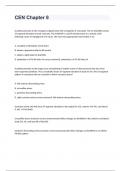
-
CEN Chapter 8 exam 2024 with 100% correct answers
- Exam (elaborations) • 51 pages • 2024
-
- $18.49
- + learn more
A patient presents to the emergency department with complaints of chest pain. The 12-lead EKG reveals ST segment elevation in leads I and aVL. The initial BP is 112/69 and decreases to a systolic of 60 following a dose of nitroglycerin 0.4 mg SL. The next most appropriate intervention is to: A. complete a fibrinolytic check sheet B. initate a dopamine drip for BP control C. obtain a right-sided 12-lead EKG D. administer a 0.9% NS bolus IV correct answersD. administer a 0.9% NS bolus IV ...

-
CCRN Pediatric Nursing Care Test (2024 Update) || With All Correct Solutions (Rated A+)
- Exam (elaborations) • 31 pages • 2024
- Available in package deal
-
- $15.50
- + learn more
CCRN Pediatric Nursing Care Test (2024 Update) || With All Correct Solutions (Rated A+) CCRN Pediatric Nursing Care Test (2024 Update) || With All Correct Solutions (Rated A+) A patient in hyperosolar hyperglycemic state (HHS) is being admitted with dehydration and a serum glucose level of 836 mg/dL. Which of the following additional laboratory findings should the nurse anticipate? A. decreased BUN, decreased creatinine, and elevated serum osmolality B. decreased BUN, decreased creatin...
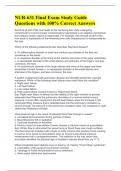
-
NUR-631 Final Exam Study Guide Questions with 100% Correct Answers
- Exam (elaborations) • 51 pages • 2024
- Available in package deal
-
- $13.99
- + learn more
Removal of part of the liver leads to the remaining liver cells undergoing compensatory Correct Answer Compensatory hyperplasia is an adaptive mechanism that enables certain organs to regenerate. For example, the removal of part of the liver leads to hyperplasia of the remaining liver cells (hepatocytes) to compensate for the loss. Which of the following statements best describes Raynaud disease? a. An inflammatory disorder of small and medium-size arteries in the feet and sometimes in the...
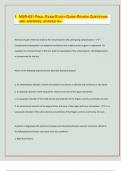
-
NUR-631 FINAL EXAM STUDY GUIDE REVIEW QUESTIONS AND ANSWERS| 2024/2025 Exam PREDICTIONS|, GRADED A+/
- Exam (elaborations) • 119 pages • 2024
- Available in package deal
-
- $11.99
- + learn more
NUR-631 FINAL EXAM STUDY GUIDE REVIEW QUESTIONS AND ANSWERS, GRADED A+/ Removal of part of the liver leads to the remaining liver cells undergoing compensatory - - Compensatory hyperplasia is an adaptive mechanism that enables certain organs to regenerate. For example, the removal of part of the liver leads to hyperplasia of the remaining liver cells (hepatocytes) to compensate for the loss. Which of the following statements best describes Raynaud disease? a. An inflammatory disorder o...
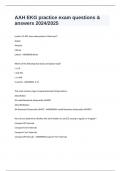
-
AAH EKG practice exam questions & answers 2024/2025
- Exam (elaborations) • 7 pages • 2024
- Available in package deal
-
- $8.49
- + learn more
AAH EKG practice exam questions & answers 2024/2025 Leads II, III AVF view what portion of the heart? Septal Anterior Inferior Lateral - ANSWERSInferior Which of the following ECG leads are bipolar leads? I, II, III I and AVL I, II, AVR II and AV - ANSWERSI, II, III The most common type of supraventricular Tachycardia is: Atrial flutter AV nodal Reentrant tachycardia (AVNRT) Atrial fibrillation AV Reentrant Tachycardia (AVRT) - ANSWERSAV nodal Reentrant tachycardia (AVNRT)...
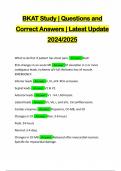
-
BKAT Study | Questions and Correct Answers | Latest Update 2024/2025
- Exam (elaborations) • 19 pages • 2024
- Available in package deal
-
- $11.99
- + learn more
BKAT Study | Questions and Correct Answers | Latest Update 2024/2025 What to do first if patient has chest pain. - Answer -Rest! ECG changes in an acute MI - Answer -ST elevation in 2 or more contiguous leads. Ischemia d/t full thickness loss of muscle. EMERGENCY. Inferior leads - Answer -II, III, aVF. RCA occlusion. Septal leads - Answer -V1 & V2. Anterior leads - Answer -V1 - V4. LAD lesion. Lateral leads - Answer -V5, V6, I, and aVL. Circumflex lesion. Cardiac enzymes - Answer -Tro...
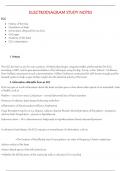
-
ELECTRODIAGRAM STUDY NOTES 2024/2025
- Summary • 73 pages • 2024
- Available in package deal
-
- $21.49
- + learn more
ECG History of the ECG. Orientation of leads Information obtained from an ECG ECG paper Anatomy of the heart ECG interpretation 1. History The ECG has been in use for over a century. A British physiologist, Augustus Waller, performed the first ECG recording in 1887, and he gave demonstrations of his technique, using his dog, Jimmy, as the “patient”. Einthoven, from Holland, was present at such a demonstration. Willem Einthoven constructed his well-kno...

How much did you already spend on Stuvia? Imagine there are plenty more of you out there paying for study notes, but this time YOU are the seller. Ka-ching! Discover all about earning on Stuvia


